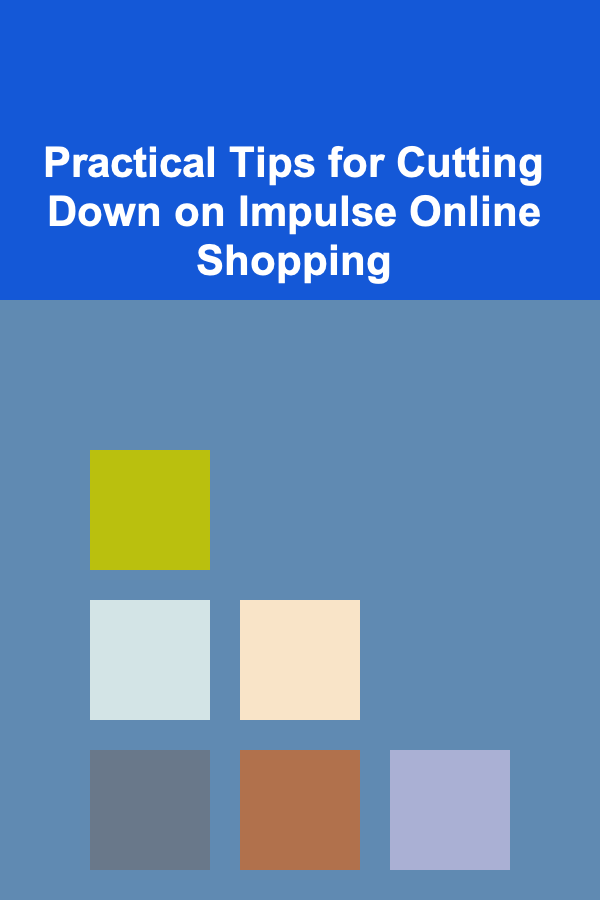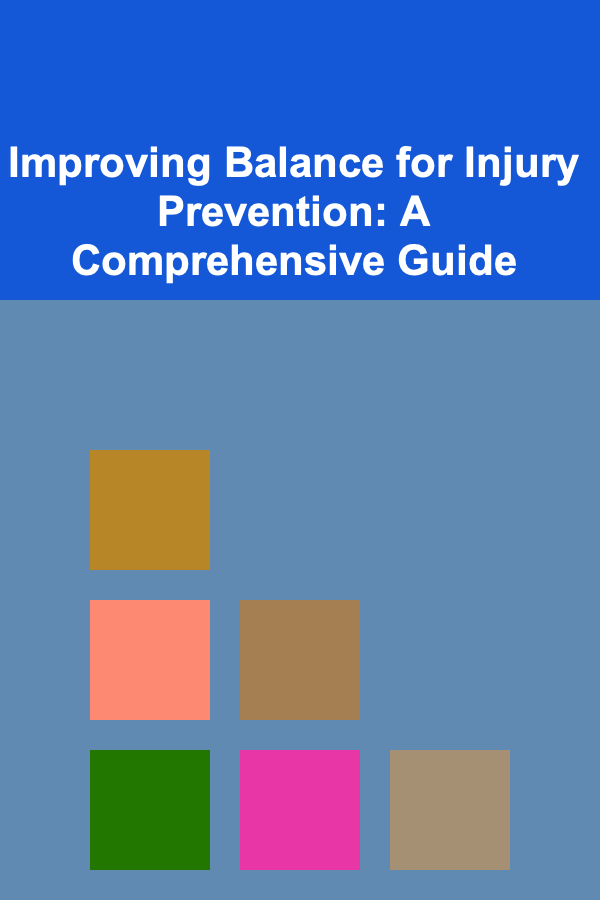
Practical Tips for Cutting Down on Impulse Online Shopping
ebook include PDF & Audio bundle (Micro Guide)
$12.99$11.99
Limited Time Offer! Order within the next:

In today's fast-paced, digital-driven world, online shopping has become more accessible than ever. With just a few clicks, we can have almost anything delivered to our doorsteps. While this convenience is undoubtedly a blessing, it also comes with the downside of impulse buying. The ease of browsing, the constant bombardment of targeted ads, and the urgency of flash sales can make it challenging to resist the temptation of buying things we don't truly need.
Impulse online shopping can quickly lead to overspending, clutter, and regret. But the good news is that with some intentional strategies and mindful habits, you can regain control over your spending and reduce impulse buys. This guide provides actionable tips that will help you cut down on impulse online shopping, save money, and make more intentional purchasing decisions.
Understand the Psychology Behind Impulse Buying
To break free from impulse online shopping, it's essential to understand why we fall into these buying patterns. Here are some psychological triggers that fuel impulse shopping:
- Instant Gratification: The thrill of a "quick fix" or the anticipation of a product arriving at your door can trigger an emotional high. This momentary satisfaction often overrides logical decision-making.
- Limited-Time Offers: Flash sales, countdown timers, and limited stock warnings create a sense of urgency, pressuring you to act fast before the deal disappears.
- Social Influence: Ads and recommendations based on social media influencers or peer reviews can lead you to believe that buying a certain product is a must-have.
- Convenience: The ease of browsing and purchasing products on your phone or computer, combined with saved payment methods, makes it effortless to click "Buy Now."
Recognizing these triggers is the first step in taking control of your online shopping habits. The next step is developing strategies to counteract these impulses.
Create a Shopping List and Stick to It
One of the most effective ways to avoid impulse purchases is to create a list of the items you truly need before shopping. A shopping list acts as a boundary to keep you focused and disciplined. Here's how you can make the most of this strategy:
How to Make a Shopping List:
- Define Your Needs: Take a moment to evaluate whether the items on your list are things you truly need. If you're tempted to add something extra, ask yourself if it will add value to your life or if it's simply a fleeting desire.
- Set a Budget: Along with your list, set a strict budget for how much you're willing to spend. This will help you make more thoughtful decisions while browsing.
- Use a Note-Taking App: Keep your shopping list on your phone or in a digital note-taking app, which allows you to easily add or remove items. You can refer back to it whenever you feel tempted to shop impulsively.
Benefits:
- Helps eliminate unnecessary purchases.
- Forces you to focus on what you genuinely need, reducing the chances of purchasing things driven by fleeting emotions.
- Encourages financial discipline by setting a clear limit on spending.
Unsubscribe from Promotional Emails and Notifications
A significant part of the impulse shopping experience comes from the flood of promotional emails, sale alerts, and personalized product recommendations that fill your inbox daily. These emails often create a sense of urgency or encourage "limited-time" purchases. Unsubscribing from these emails can significantly reduce the temptation to shop impulsively.
How to Unsubscribe:
- Opt Out of Newsletters: Take the time to unsubscribe from email newsletters that don't provide value. If you're subscribed to multiple retail stores or deal sites, consider removing yourself from their mailing list.
- Turn Off Push Notifications: Many online stores send push notifications on your phone, alerting you to flash sales, price drops, or new arrivals. Turn off these notifications to minimize distractions and reduce the urge to shop.
- Use Email Filters: Set up email filters to send promotional emails directly to a separate folder, so you're not constantly reminded of sales and new products.
Benefits:
- Reduces exposure to tempting offers and flashy sales.
- Helps you stay focused on your goals without constant distractions.
- Minimizes the risk of falling for psychological triggers like FOMO (fear of missing out).
Implement the "24-Hour Rule"
One of the simplest yet most effective techniques to curb impulse buying is the "24-hour rule." The concept is straightforward: when you find something you want to purchase but don't urgently need, give yourself 24 hours before making a final decision.
How the 24-Hour Rule Works:
- Wait Before You Buy: When you feel the impulse to buy something, close the tab or app and walk away from it. Wait at least 24 hours before revisiting the item.
- Evaluate Your Desire: After the waiting period, ask yourself whether you still feel the need to purchase the item. Often, the initial excitement will fade, and you'll realize that the purchase wasn't necessary after all.
- Reflect on the Emotional Trigger: During the waiting period, reflect on what motivated the impulse---whether it was an ad, an emotional trigger, or peer pressure. Understanding the underlying cause can help you avoid similar temptations in the future.
Benefits:
- Gives you time to reflect on whether the purchase is truly necessary.
- Helps break the cycle of instant gratification and encourages mindful decision-making.
- Increases awareness of emotional triggers, allowing you to act more intentionally.
Use Budgeting Apps to Track Your Spending
An easy way to gain more control over your finances and reduce impulse purchases is by using budgeting apps. These apps allow you to set spending limits, track your purchases, and visualize how much you're spending on non-essential items.
How to Use Budgeting Apps Effectively:
- Set Clear Categories: Organize your spending into categories (e.g., groceries, entertainment, online shopping) and set a budget for each. This way, you can clearly see where your money is going.
- Track Every Purchase: Record every purchase, no matter how small, and review it regularly. This will give you a clearer picture of how much you're spending on unnecessary items.
- Set Alerts: Many apps let you set alerts when you're nearing your spending limit. This can serve as a wake-up call when you're about to overspend.
Benefits:
- Helps you stay accountable to your financial goals.
- Provides insight into your spending habits and helps identify patterns of impulse buying.
- Makes it easier to stick to a budget and prioritize essential purchases.
Clear Your Shopping Cart Before Checkout
Another effective tip is to make it a habit to review and clear your shopping cart before completing any online purchase. It's easy to add items to your cart in the heat of the moment, but it's crucial to pause and reconsider before proceeding to checkout.
How to Clear Your Cart:
- Pause Before Checkout: Before clicking "Buy Now," review the items in your cart and ask yourself if they are essential. If you're unsure, leave the cart for a while and return later.
- Remove Unnecessary Items: If you find that your cart is filled with items you don't truly need, delete them. If you feel conflicted, use the 24-hour rule and come back to the decision later.
- Focus on Priorities: Stick to purchasing only the items that align with your current goals, needs, or budget.
Benefits:
- Encourages a final moment of reflection before committing to a purchase.
- Reduces the likelihood of accidental impulse buys during checkout.
- Keeps your focus on the items that truly matter and are within your budget.
Set Specific "Shopping Days"
Instead of browsing online whenever you feel the urge to shop, set designated days each month or week when you'll allow yourself to shop. This structured approach limits the frequency of online shopping and helps you stick to your goals.
How to Implement Shopping Days:
- Choose Specific Days: Choose one or two days a month or week where you allocate time for browsing and purchasing items you genuinely need.
- Stick to Your Schedule: Avoid spontaneous online shopping outside of these days. If an item is urgently needed, consider using your 24-hour rule to assess whether it's truly necessary.
- Use a Shopping Budget: Pair your shopping days with a fixed budget to further limit spending.
Benefits:
- Helps create boundaries and reduces the urge to shop impulsively.
- Encourages mindful shopping and prioritizes long-term needs over short-term wants.
- Provides structure, so you're less likely to shop out of boredom or emotional stress.
Conclusion
Cutting down on impulse online shopping isn't about depriving yourself of the occasional treat, but rather about making intentional, mindful decisions about what you truly need. By understanding the psychological triggers that fuel impulse purchases and implementing strategies such as the 24-hour rule, tracking your spending, and setting boundaries for shopping, you can regain control over your finances and avoid the cycle of buyer's remorse.
The key is not to eliminate online shopping altogether, but to approach it with a more deliberate and thoughtful mindset. Over time, these habits will help you create a healthier, more sustainable relationship with shopping, resulting in both financial and emotional satisfaction.
Reading More From Our Other Websites
- [Skydiving Tip 101] From Tandem to Solo: My Journey to Becoming a Certified Solo Skydiver
- [Home Pet Care 101] How to Maintain a Clean and Healthy Environment for Your Pet
- [Sewing Tip 101] The Essential Sewing Toolkit: Must-Have Tools for Every Stitcher
- [Paragliding Tip 101] Building a Flight Crew Community: Facebook Group Strategies for Paragliders
- [Personal Finance Management 101] How to Build a Credit History from Scratch
- [Personal Financial Planning 101] How to Do Estate Planning: Ensuring Your Financial Legacy
- [Home Pet Care 101] How to Groom Your Pet at Home: Tools and Techniques
- [Personal Care Tips 101] How to Use Hair Mousse to Achieve a Luscious, Full Head of Hair
- [Gardening 101] The Best Herbs to Grow in Your Herb Garden for Cooking and Health
- [Personal Care Tips 101] How to Make DIY Face Masks for Glowing Skin

How to Turn Your Sewing Skills into a Full-Time Side Hustle
Read More
Simple and Affordable Home Improvement Ideas for Every Room
Read More
The Step-by-Step Guide to Effective Study Habits
Read More
Improving Balance for Injury Prevention: A Comprehensive Guide
Read More
10 Tips for Creating a Baby Nursery Design Plan with a Planner
Read More
10 Tips for Cinematographers Shooting Documentary Filmmaking
Read MoreOther Products

How to Turn Your Sewing Skills into a Full-Time Side Hustle
Read More
Simple and Affordable Home Improvement Ideas for Every Room
Read More
The Step-by-Step Guide to Effective Study Habits
Read More
Improving Balance for Injury Prevention: A Comprehensive Guide
Read More
10 Tips for Creating a Baby Nursery Design Plan with a Planner
Read More